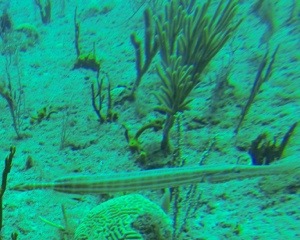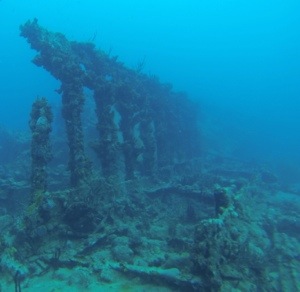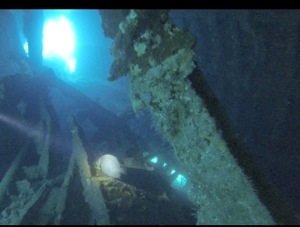My hut awoke to the sharp buzzing sound of the alarm clock. Then we all prepared for our short, basic breakfast at the Dive BVI office. At the office everyone ate bread, cereal, poptarts, and a large assortment of fruit.
After breakfast the marine biology one group headed out to the Rhone wreckage site on the coast of salt island to explore the colorful, diverse range of marine animals living amongst the artificial reef formed from the various remnants of the Rhone. Once their we were quickly briefed before heading down to explore. During the briefing we were informed that the Rhone had sunk during the 1800’s and was over three-hundred feet long. After reaching the ocean floor we began touring the bow of the ship which was the most intact piece and was covered with marine wildlife. Once we got down there we immediately saw a three foot long Hawksbill turtle encircling the Rhone. While down there we saw a large variety of colorful sponges that had settled themselves on the deck. We also saw a large snapper roaming the deck. Directly outside the fringes of the Rhone we saw two groups of Reef squid in a pack swimming. There was an area in the wreck where divers were allowed to do a swim thru of part of the dilapidated ship, which we unanimously voted to do. In the wreck it was nearly pitch black, but luckily our dive instructor ,Caitlyn, had prudently taken a flashlight with her. In the wreck we saw a lot of nocturnal predators that seek shelter during the day but come out to hunt during the night. The amount of wildlife in the Rhone was pretty scarce though. Within the dark wreckage of the Rhone we saw a large two-foot long angel fish and a squirrel fish. In the darkness I hit my tank on the ceiling three times causing a large thud to be echoed throughout the ship. Once out of the ship another Hawksbill turtle was spotted and a long sleek shiny barracuda. The artificial reef on the wreckage had more fish than our other dive sites did. After scrutinizing nearly every fish on the wreck, we ascended and prepared our gear for a second dive down to the smaller stern of the Rhone. Before heading into the water Jeff outlined the causes of the crash and the general story of why it occurred, as well as whom survived. Apparently the only ones to survive were twenty-two of the crewmen and one of the passengers. The porthole inhabited by the lone passenger survivor is said to be lucky and should be rubbed three times in order to supposedly get money, food, and girls, according to Jeff. After the historical overview we jumped into the water and descended quickly. Once at the wreckage site we swam around the ship and then eventually above it. During the tour there was a mild current causing us to use more energy and in turn increase air consumption. The reef formed by this wreckage site didn’t harbor as much marine wildlife as the first wreckage site, but nevertheless it was just as interesting and fun. At this site we saw mostly the same fish as the first except for a rare queen triggerfish that we saw towards the end. Other wildlife we saw included the spotted trunkfish, bar jack, barracuda, and blue tang. This site had a swim through section of a crevice formed from a rock and the massive propeller. In this small, short swim through we discovered the true size of the ship by witnessing the size comparison of the ships propeller to a person. Throughout this dive Jeff took multitudes of pictures. After exhausting our air supply we ascended to the boat and prepared for a boat drive to Cooper Island for lunch.
After the boat ride to Cooper Island we had to wait for our lunch to be prepared. During this wait we saw a medium sized stingray gliding across the bottom. Once the wait ended we had a delicious fish and chips dish at a restaurant on the coast of cooper island. The fish was made from mahi-mahi.
Once lunch ended we snorkeled at a site near the beach that was ridden with sea grass and was a habitat perfect for turtles. At this site we saw a couple of hawksbill turtles and many sting rays. This site was different than any other site we had previously been to because of the different environment which drew a different group of animals. Also at this site was some type of red coral which I hadn’t seen before. Towards the end of the snorkel we saw two large tarpin hovering beneath our boat which had a body shape similar to a shark.
We headed back to Virgin Gorda after the snorkel to take a quick break at our cabins and prepare for dinner. After break we headed to mad dogs for a quesadilla dinner followed by work with our dive logs. Once we finished working with our logs we took a group picture of both marine biology one and two in front of the bar at mad dogs. Next we left mad dogs for the last time and strolled back to the huts to blog and doze off to sleep after a long exhausting day of diving and snorkeling.







